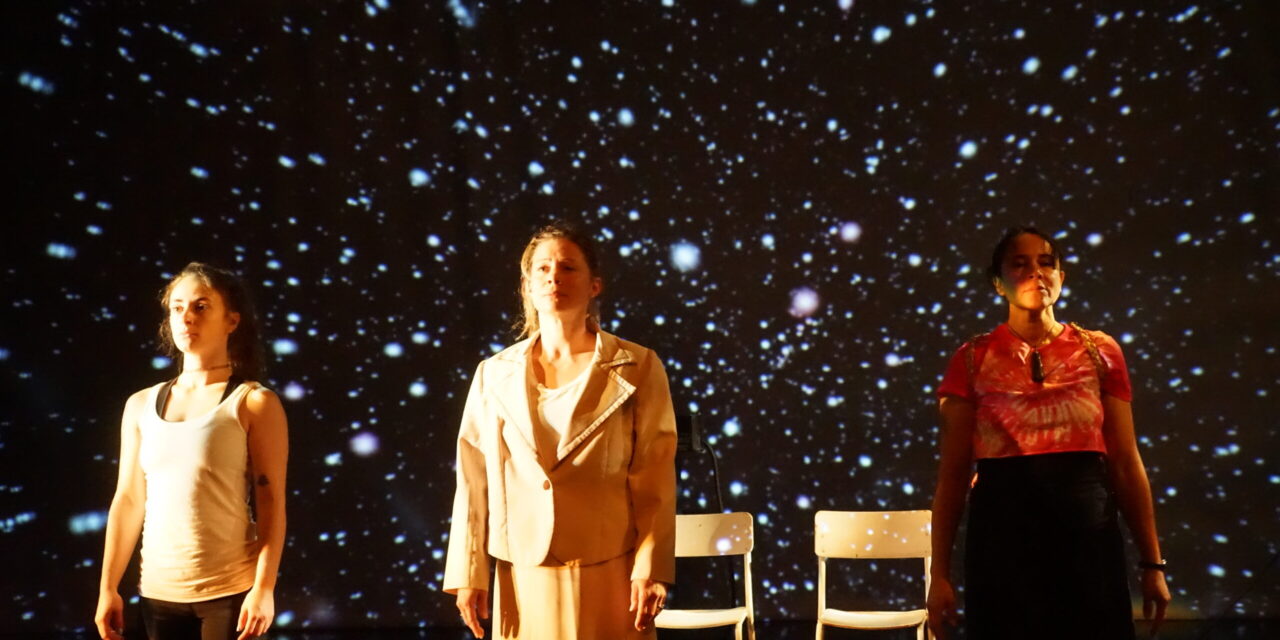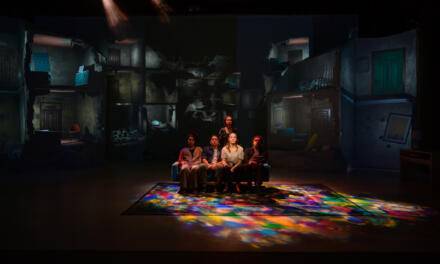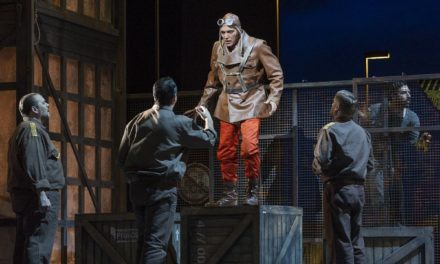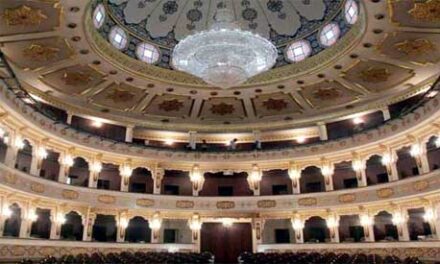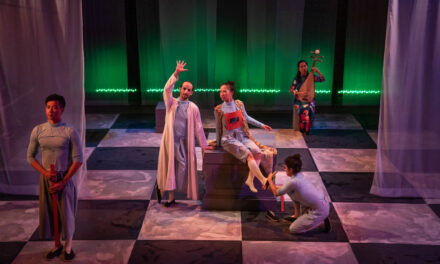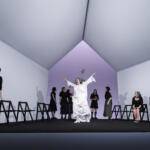In the era of Covid 19, when our theatres have been forced to close throughout Aotearoa/New Zealand, we find ourselves unable to rehearse or to present our work to a live audience. This has created valuable space for revisiting and re-examining some of the theatre we have produced over the past year. In this article we reflect on the process of making Fission, a collaborative work created by theatre-makers and scientists in Dunedin, New Zealand. Fission was performed at Allen Hall Theatre, Dunedin as part of the 2019 Fringe Festival from March 26 – 30th, and was a work-in-progress presentation following a development process that had been in operation since 2016. Inspired by Lawrence and Mary Halprin’s RSVP Cycles, which also inform Robert Lepage’s dramaturgy and performance creation practices[1], we committed to a long-term interdisciplinary devising process where the process itself was as important as the theatrical work we would eventually create. In retrospect, the emphasis we placed upon liveness and the many connections between creativity and science that were made manifest by the co-presence of the artists in the workshop space and were to become eerily relevant in an era when co-presence was prohibited.
Arts and sciences are often set up in opposition to each other but the more we collaborated together, the more connections we discovered between them. The project was initially inspired by articles on Collaborative Science Theatre and the “Sci-Arts” movement in the U.K. “where scientists are actively involved in the development of the performance” rather than simply the subject of the performance, as in plays like Michael Frayn’s Copenhagen and Tom Stoppard’s Arcadia.[2] Dowell and Weitkamp suggest that in such projects “it might be possible for scientist collaborators within these projects to have as integral a role as any other member of the team; a role not purely as an external advisor but as an equal creative partner with a clearly defined skill”.[3] As the Fission project was developed over a two-year period of workshops, theatre practitioners worked alongside David Hutchinson, Professor of Physics and Director of the Dodd-Walls Centre for Quantum and Photonic Technologies, who became equally involved in the creative process. One of the core initiators of the project – Rua McCallum (Ngāi Tahu), a theatre-maker and researcher working in the area of mātauranga Māori (Māori knowledge), brought significant expertise from both Te Āo Māori (the Māori world), and scientific research. Because the creative team were committed from the outset to bicultural performance processes, we worked with fundamental processes from Te Āo Māori and investigated connections between science and mātauranga Māori.
The First Workshop
The first workshop was held at Allen Hall Theatre in December 2016 and drew together Rua McCallum, David Hutchinson, Dr Ian Griffin (astrophysicist and Director of the Otago Museum), dancer Megan Wilson, scenographer and lighting designer Martyn Roberts, technician Anna van den Bosch and directors Hilary Halba and David O’Donnell. The workshop was framed by tikanga Māori (Māori protocols), beginning with a mihimihi (welcome and introductions). Initial investigations focussed on connections between Indigenous and scientific knowledge. Rua McCallum explained ways in which quantum physics sits alongside many Indigenous narratives, telling the same story that science does in a different way. For example, the Māori concept that the universe was formed out of Te Kore (nothingness), that Te Kore contains the potential for everything, has some parallels with the scientific theory of the Big Bang. As the scientists outlined the history of physics, the artists began to see connections with theatre. As one participant put it, both physics and theatre aim to “help people to imagine things that aren’t there.” The scientists spoke of the beauty of the universe and the beauty in their research, which accorded with the artists’ desire to create beauty through theatre. An early inspiration was a quotation from Albert Einstein: “The most beautiful thing we can experience is the mysterious. It is the source of all true art and science.” The artists in the room were particularly drawn to Dr Ian Griffin’s story about New Zealand scientist Ernest Rutherford’s desk, which had to be isolated in a university museum, unable to be displayed because it had retained the radioactivity from Rutherford’s experiments a century before. Our research group began to build a resource of such scientific stories, experiments and theories which could become the basis of a collection of scenes. Although part of the aim was to excite and interest audiences in physics, the group wanted to create a work of art, not a science communication project geared towards education. A decision was made to focus on abstraction as an artistic principle, because whenever the group attempted to stage a scientific principle too literally, the scene veered towards the science-education model and we lost the complexity – as well as some of the beautiful mystery – of the underlying scientific principles.
With the principle of building up layers of abstraction and mystery in mind, the group devised three scene fragments or ‘movements’ from that initial workshop to present to an invited audience. When Martyn Roberts demonstrated effects he could achieve with theatre lights, the scientists were excited to witness the lights representing principles of pure physics as Martyn experimented with various effects such as very low light levels on a moving dancer, and beams of light shone through haze. The first ‘movement’ represented an encounter between a dancer and Rutherford’s radioactive desk. The radioactivity was suggested by the dancer’s jerky movements as well as pulsating theatre lights and electronic sounds. The second ‘movement’ represented aspects of wave-particle duality, and the third string theory, using lighting, sound and movement. The ‘wave-particle duality’ scene showed the dancer moving around the darkened space. Random lights would flash intermittently, and if the dancer was caught in the light her whole body gyrated frenetically until the light was switched off. This metaphorically signified the enhanced uncertainty in the momentum of the particle (dancer) when their spatial location (in the light) was restricted, illustrative of Heisenberg’s Uncertainty Principle. The representation of string theory was the least successful of our theatrical experiments in that we used interconnected strings to illustrate the concept but it appeared too literal and lacked theatricality. The reception from the small audience of theatre practitioners and scientists was encouraging. One of the scientists correctly understood that the abstracted second movement represented wave-particle duality because it reminded him of his own quantum intuition derived through his research.
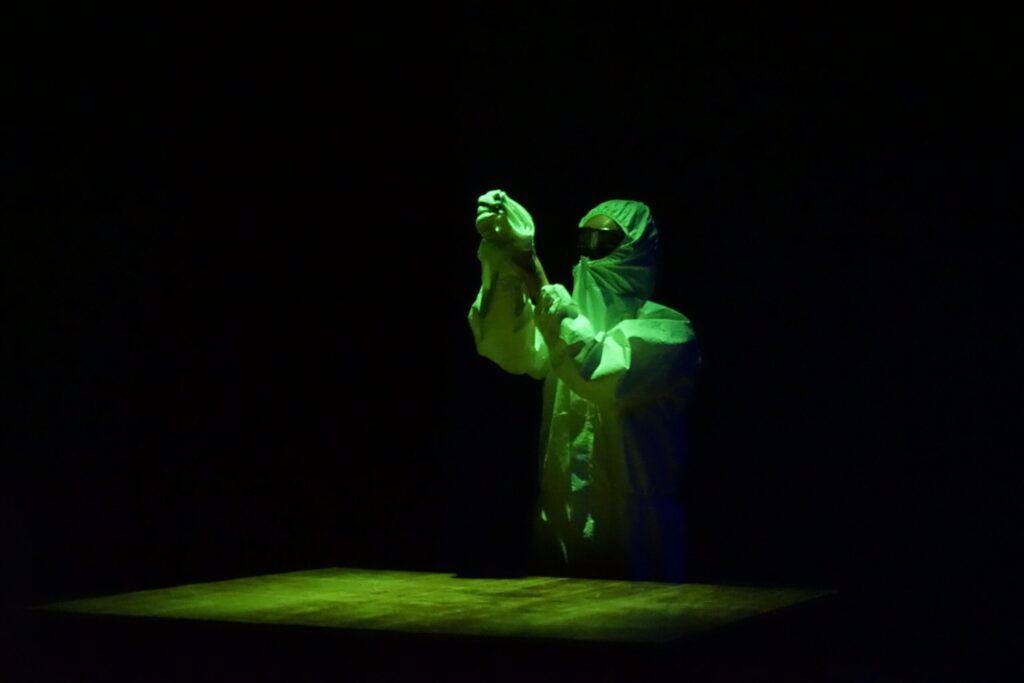
Katherine Kennedy performing the ‘Rutherford’s Desk’ sequence, Fission, Allen Hall Theatre, Dunedin, Aotearoa/New Zealand, March 2019. Photo: Martyn Roberts.
Subsequent workshops
Following extensive de-briefing and planning, a second workshop was held in April 2017. The collaborators had been stimulated by the previous workshop, and were beginning to establish some shared language and principles. The group realised that theatre and science share a number of common principles: both are always in a state of experimentation, of provisionality – nothing is ever quite finished; they share a deep interest in space and light, and both use metaphor constantly to attempt to make sense of the world. In quantum physics, the world really is not the way that we perceive it. Scientists, like artists, use imagination and intuition in conducting experiments and evolving theories. Imagination fills the gaps that are created by logic. Ernest Rutherford’s view that well-constructed scientific theory was a work of art fortified our goal that the project was not aimed at using art to illustrate science, but rather sought to explore intersections between art and science.
In the second workshop the original collaborators were joined by violinist Tessa Peterson and actor Richard Huber. The addition of a musician provided an exciting new dimension, as David Hutchison suggested that the score of written music is similar to the mathematical framework used by a theoretical physicist. He suggested it was possible to “play” an equation as a piece of music. David worked with Tessa Peterson to transpose the ratios of energies in the hydrogen spectrum into a musical notation which Tessa then played on the violin. This experiment produced a haunting and distinctive piece of music, which because part of the workshop and performance process from then on.
During this workshop, the group became interested in the life story of the Austrian-Jewish physicist Lise Meitner (1878-1968) who coined the term Nuclear Fission and published the first theoretical explanation of the fission process. Despite her achievements, Meitner was overlooked for the Nobel Prize in chemistry which was awarded to her collaborator Otto Hahn in 1944. Lise Meitner’s outstanding achievements in physics became a kind of touchstone for the experimentation in the rehearsal room, and the group determined that aspects of Meitner’s story would be incorporated into the structure of the piece.
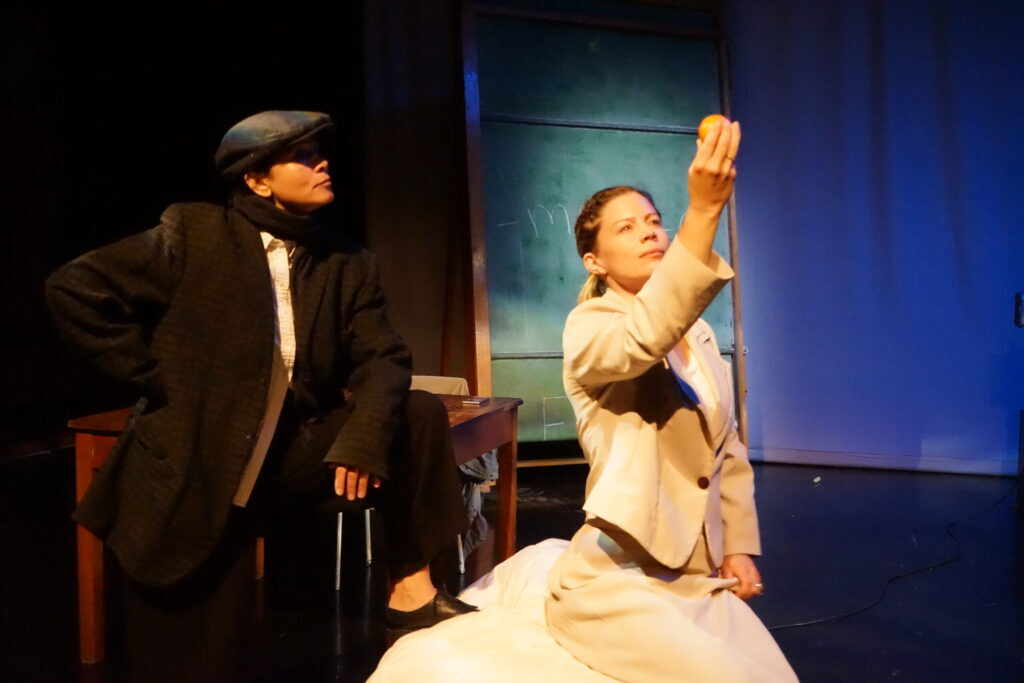
Kiri Bell as Otto Hahn and Jodie Bate as Lise Meitner consider splitting the atom, Fission, Allen Hall Theatre, Dunedin, Aotearoa/New Zealand, March 2019. Photo: Martyn Roberts.
A great deal of new material was generated in the second workshop. Various scenes attempted to theatricalise concepts like the speed of light, the idea that the observation of an event can effect a change in that event, the most well-known – and strange – example of which is the double slit experiment[4], and particularly quantum entanglement – a concept that continued to engage us throughout the project. Quantum entanglement proposes that measurement of properties of an object at one point in the universe can instantly affect the properties of a distant object at another point in the universe – a occurrence that Einstein had called “spooky action at a distance”. We also experimented with a number of other ideas: for instance, Rutherford’s “gold foil” experiment was staged using three actors in a triangle at the fringes of the space rolling balls across the stage. The balls collided, smashing against each other. Then we added gravity; balls fell, were thrown, and dropped into the space. The random collisions and pathways of the balls suggested the atomic world. We experimented with ultraviolet light so that the balls were the only thing visible in the dark space. Although these theatrical experiments were intriguing, we agreed that we were drifting too closely towards the science communication form we had earlier decided to avoid.
Further research and meetings in 2017 and 2018 led to a third workshop in June 2018. The original collaborators were now proposing that there is no disconnect between arts and sciences, that they are always fully integrated. The group had now expanded to include choreographer Sofia Kalogeropoulou, and actor/dancers Jodie Bate and Katherine Kennedy. We also had the benefit of input from a visiting American dramaturg, Amanda Faye Martin, who observed that the piece was concept-driven rather than character-driven, confirming our commitment to abstraction and avoiding conventional narrative structure. However, Amanda also stressed the importance of providing the audience with “clues” as to what was going on, to what aspects of physics were being explored. By this stage one of our research questions had become, how do we experience physics rather than just trying to understand it?
The group improvised scenes from Lise Meitner’s life story such as her experiments with colour as a child, her PhD graduation, her flight from Nazi Germany, and the scientific community’s failure to recognise her contribution when her research partner Otto Hahn was awarded the Nobel Prize. Quantum entanglement continued to captivate us, so we began to ‘entangle’ different research threads through choreographing a slow-motion dance sequence on Rutherford’s radioactive desk where a young, present-day female scientist encounters the ghost of Lise Meitner.
This workshop also further developed connections with Te Ao Māori, generating a sequence which presented Te Kore through Māori movements and musical instruments, blended with scientific terms and equations, evoking the coming into being of the world. This sequence used layering of diverse elements, including theatrical lighting, to physicalise a conversation between physics and mātauranga Māori. Designer Martyn Roberts experimented with different concepts of time, creating a sequence where the dancers performed a repeated action at contrasting speeds. This sequence was then filmed and projected behind the dancers while they continued to perform the repeated action. This produced a complex layering effect that suggested relationships between time, light and optics.
Inspired by Robert Lepage’s practice of integrating personal material from the actors into the devising process, scientific stories and objects brought by the participants to the workshop were used as scene provocations. This included a small girl’s delight in unwrapping a Christmas present to discover a microscope, through which she observes a dead fly, and an ironic narrative about one of the performers having a contraceptive device inserted into her arm. These scenes allowed humanity to intersect with science, bringing in unexpected images, metaphor and moments of humour to the work.
During this third workshop the participants visited a physics laboratory at the Dodd-Walls Centre. This space was radically different to the science labs we were familiar with from schooldays. The group were struck by the density of clutter in the laboratory, particularly the jumble of thick cabling, wires, lenses and mirrors. The scene seemed to evoke the chaos of the universe. This visit inspired further scenographic experimentation, including the creation of a scene where the rehearsal room was filled with electrical cables and a clutter of vintage science objects. Two dancers dressed as cleaners entered the space and began to tidy it. The cleaners discovered Māori objects – a kete (woven basket), a patu (short club), a hoe (canoe paddle) – among the clutter, and began to chant in te reo (Māori language) and enact movements inspired by Māori movement and martial arts. The dancers then animated the electrical cords and plugs so that the stage was filled with a tangle of snake-like cables. This image evoked not only the literal picture of the laboratory we had visited but also depicted entanglements and synchronicities between Māori cosmologies and scientific theories.
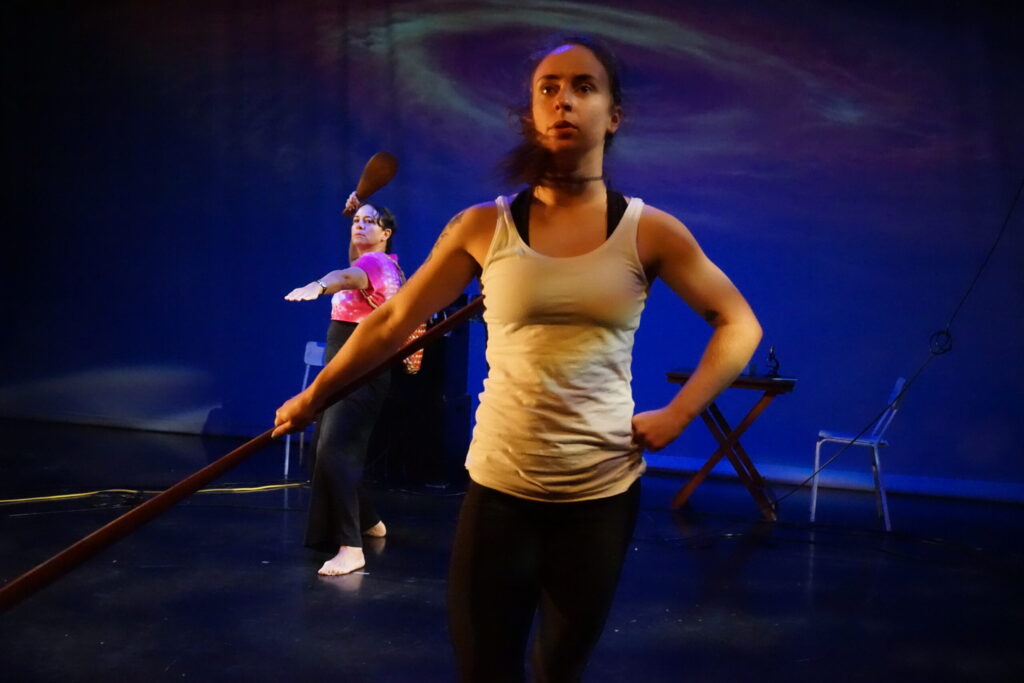
Kiri Bell as Ria and Katherine Kennedy as Lisa perform with patu (short club) and taiaha (long staff), Fission, Allen Hall Theatre, Dunedin, Aotearoa/New Zealand, March 2019. Photo: Martyn Roberts.
The fourth workshop was held in December 2018. By this stage the production of Fission was programmed to be performed in the Dunedin Fringe Festival in March the following year, so the focus moved from broad experimentation and generating new material, to consolidation. Playwright and actor Kiri Bell joined the group with the mission of creating some scripted elements for the performance to juxtapose against the movement-based sequences. Following Amanda Faye Martin’s advice to provide clues to help the audience, Jodie Bate developed a series of monologues based on the online popular science videos that the group had been watching to help our understanding of complicated theories of physics. The vlogging videos Jodie created were simultaneously informative and parodic, bringing further humour to the work.
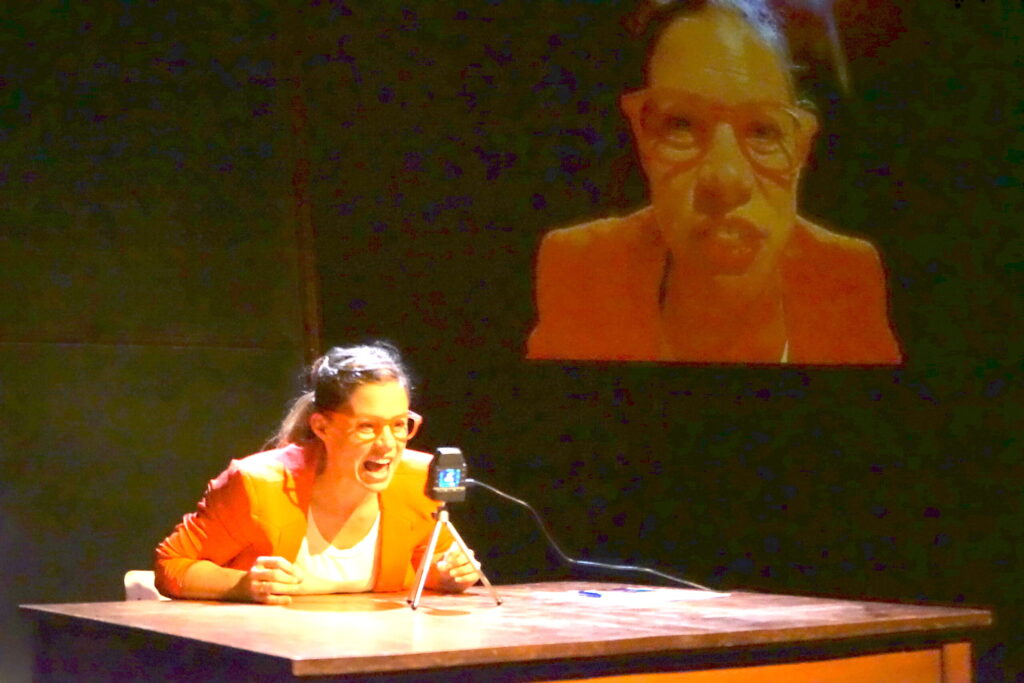
Jodie Bate as Lisse the physicist and vlogger, Fission, Allen Hall Theatre, Dunedin, Aotearoa/New Zealand, March 2019. Photo: Martyn Roberts.
While the actors in Fission portrayed a range of concepts and personas, by this stage we had settled on a core group of characters that would remain constant throughout. These were all variations on Lise Meitner’s Christian name: Lisse – a Physics professor and vlogger, Lisa – a performance artist, Ria (the Māori translation of Lisa) – a Māori artist, and Lise Meitner herself. We were struck by the poetic synchronism of a group of women connected through time and space by their names and by an interest in science; the idea also reflected the principle of quantum entanglement that had preoccupied some of our workshop experiments. At one point, Lisse and Lisa literally bump into each other several times in a café like atoms bouncing off each other. We sought to reflect the principle that each person is a random collection of atoms and chemical reactions that are intrinsically connected to a multitude of different atoms elsewhere in time and in the universe.
The Production
Fission, the performance work that resulted from these interdisciplinary experiments, was staged in March 2019. The piece was both poetic and metaphoric, often relying on the body, juxtapositions between the body, light and objects, and visual imagery to symbolise and depict the complex ideas we were seeking to evoke. Although not entirely narratively driven, the work nonetheless followed the four characters we had developed in the workshops: Lisa, Lisse, Lise and Ria. Fission’s visual imagery focussed primarily on lighting and AV effects, and offered a multiplicity of meanings that expressed both concepts from the world of physics, but also a sense of the unknowability of the universe, large and small. When Lise Meitner appeared on the stage, she was always accompanied by Tessa Peterson’s violin piece, based upon the spectrum of hydrogen, which we named ‘Lise Meitner’s sting’. The science objects used in the devising process were all at least fifty years old (a valve radio, a tin spinning top, an old-fashioned revolving roller chalkboard, a vintage camera, a microscope) and were also employed in multiple ways in the performance, thus becoming symbolically significant in the work.
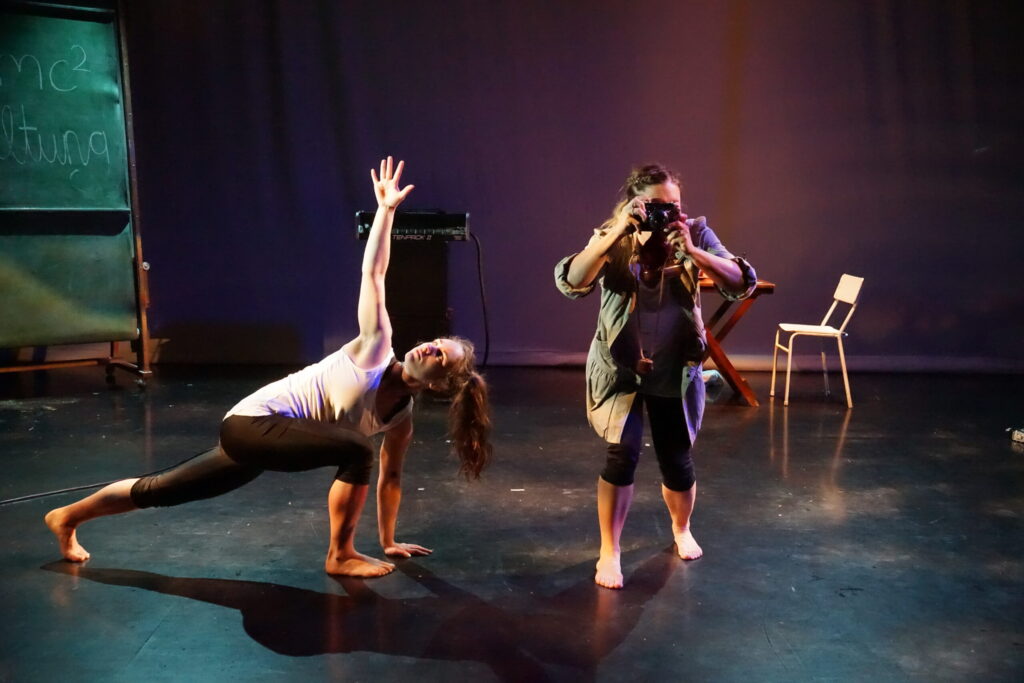
Katherine Kennedy as Lisa and Jodie Bate as Lisse, Fission, Allen Hall Theatre, Dunedin, Aotearoa/New Zealand, March 2019. Photo: Martyn Roberts.
After her contribution to splitting the atom, Meitner was called ‘the Mother of the Atom Bomb’ – an appellation she reviled – and was said to have ‘left Germany with the bomb in her handbag’. Drawing on these vivid descriptions in our image-making in Fission, we depicted Meitner as always carrying a handbag. In a highly charged scene, she listened to a World War II airman’s description – emitting from the valve radio – of the atomic bomb being dropped on Hiroshima. In slow motion, Lise opened her handbag, from which a green light radiated, and silently ‘screamed’[5] as the harrowing description continued unabated. This scene represented the fact that Meitner was a pacifist, and she abhorred the idea that her scientific discoveries had contributed to such human misery and destruction.
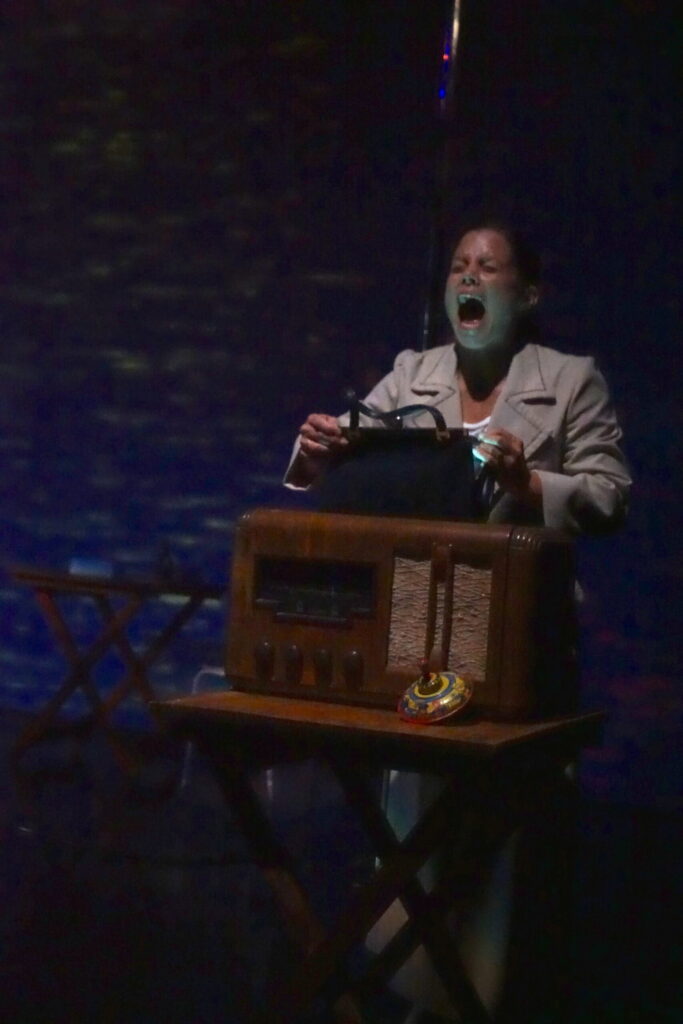
‘The Silent Scream’ – Jodie Bate as Lise Meitner, Fission, Allen Hall Theatre, Dunedin, Aotearoa/New Zealand, March 2019. Photo: Martyn Roberts.
Fission also depicted knowledge to do with the universe from a Māori perspective, often using bodies to signify this knowledge. Not only did the performers’ bodies signify in and of themselves, but they also inscribed the stage with spatial knowledge from a Māori viewpoint. For example, a sequence we called ‘Bicultural Symmetry/Atom Rhythm’ employed symmetrical and complementary choreography to illustrate cosmogenesis, with the corporeality of the actors’ bodies, breath and the pattern of their movement on the floor representing a whakapapa (genealogy) that began at the dawn of time and space, but that also expressed the scientific concept of quantum entanglement.
After Lisse (the physicist) and Lisa (the performance artist) first met early in the play, Lisse approached Lisa with an invitation to make a performance work about physics, which Lisa initially refused. As the rest of the play unfolded, there was a sense of undecidability as to whether Fission itself was, in fact, the performance that Lisse and Lisa created. We wanted to conjure for the spectator not only this sense of ambiguity as to whether Fission was a performance-within-a-performance, but also to evoke the ‘observer effect’ from the world of physics. Lisa’s initial reluctance to make the performance piece reflected the rehearsal testimony of the actor playing that character: “I know virtually nothing about physics. I was useless at it in high school, and I dropped science as soon as I could. I couldn’t understand it. And physics, it seems so – I don’t know – mechanical, I guess. It makes the universe into a machine, you know? I don’t see the universe like that. To me it’s energy. And light. Not equations and theories. So – yeah, sorry, it doesn’t really sound like my thing.”
Later in the play, Lisa phoned Lisse, revoking her refusal and agreeing to make the performance, but the phone call kept cutting out so it is never clear whether Lisse actually got the message.
In addition to experimenting theatrically with the fission after which the show was named, we also explored its opposite – fusion. A scene that fulfilled this function was ‘Rutherford’s Desk’ which we had developed further in the workshops. In performance the desk was over-washed with green light from an overhead source; a performer dressed in a hazmat suit and wearing breathing apparatus approached the desk slowly, but soon appeared to be caught up in its aura and, divesting herself of the protective equipment, she danced on and with the desk, seeming to attempt to fuse herself with it and with the actor playing Lise Meitner. This image also provided a culmination of the theatricalization of quantum entanglement which had been a consistent artistic provocation throughout the work.
In its closing moments, Fission came down on the side of the “deep awe and joy” that Lise Meitner concluded was the way in which “the natural order of things” affected a “true scientist”[6]. The play’s final image saw the actors engulfed in stars as a projected image depicting the universe’s constellations moved outwards – as if from the big bang – while the actor playing Meitner spoke one of her most memorable quotes: “Wissenschaft sorgt defur, dass menschen die realitat akzeptieren, mit einer art von staunen und bewunderung. Nicht zu vergessen, die tiefe begeisterung and freude, die naturliche ordnung der dinge einem wahren wissenschaftler bietet.” (Science ensures people accept reality with a kind of wonder and admiration. Not to mention the deep enthusiasm and joy that the natural order of things offers the true scientist.)[7]
The Fission project began as an experimental investigation that probed into the possibility of a creative endeavour between the disciplines of theatre and physics; it grew into a venture where theatre artists and scientists developed a shared theatrical language and set of creative processes that deconstructed demarcations between the arts and sciences. In this work, a scientific theory such as quantum entanglement can also become a dramaturgical and aesthetic principle. Fission also demonstrates the considerable potential of collaborative devised theatre in opening up connections between Indigenous knowledge and scientific theories.
Notes:
[1] Dundjerović, Aleksandar Saša. Robert Lepage. London & New York: Routledge, 2009.
[2] Ellen Dowell and Emma Weitkamp. “An exploration of the collaborative processes of making theatre inspired by science”. Public Understanding of Science 21 (7), 2011: 891-901, 891.
[3] Ibid., 893.
[4] An experiment that shows that light can be both a particle and a wave, and that measuring something can actually affect that thing.
[5] Referencing Helene Weigel’s famous étude as Mother Courage.
[6] Lecture Austrian UNESCO Commission (30 March 1953) in Atomenergie und Frieden: Lise Meitner und Otto Hahn (1953), 23 – 24. Trans. Ruth Sime, Lise Meitner: A Life in Physics (1996) 375.
[7] Ibid.
This post was written by the author in their personal capacity.The opinions expressed in this article are the author’s own and do not reflect the view of The Theatre Times, their staff or collaborators.
This post was written by Hilary Halba and David O’Donnell with David Hutchinson, Rua McCallum and Martyn Roberts.
The views expressed here belong to the author and do not necessarily reflect our views and opinions.

